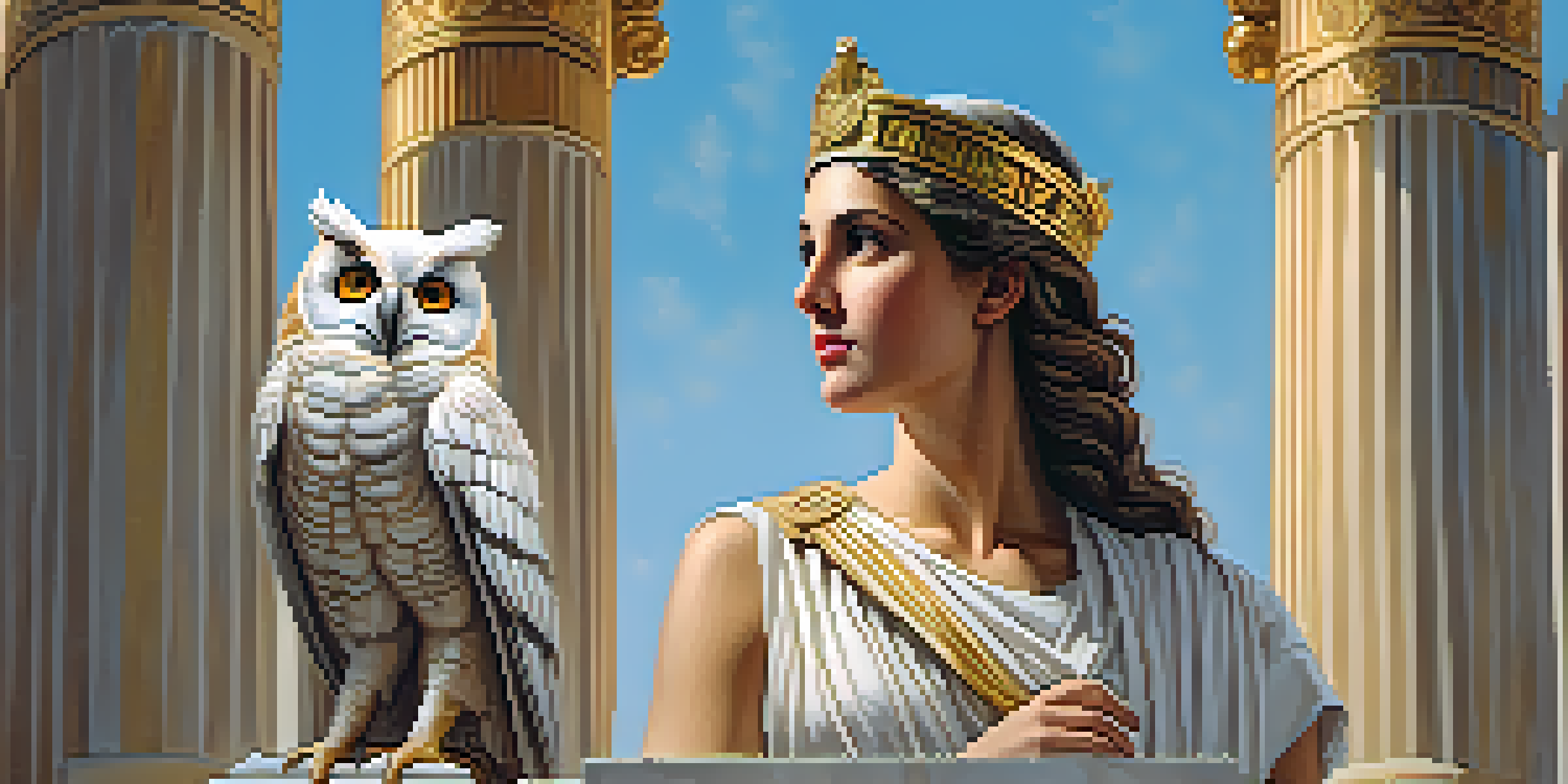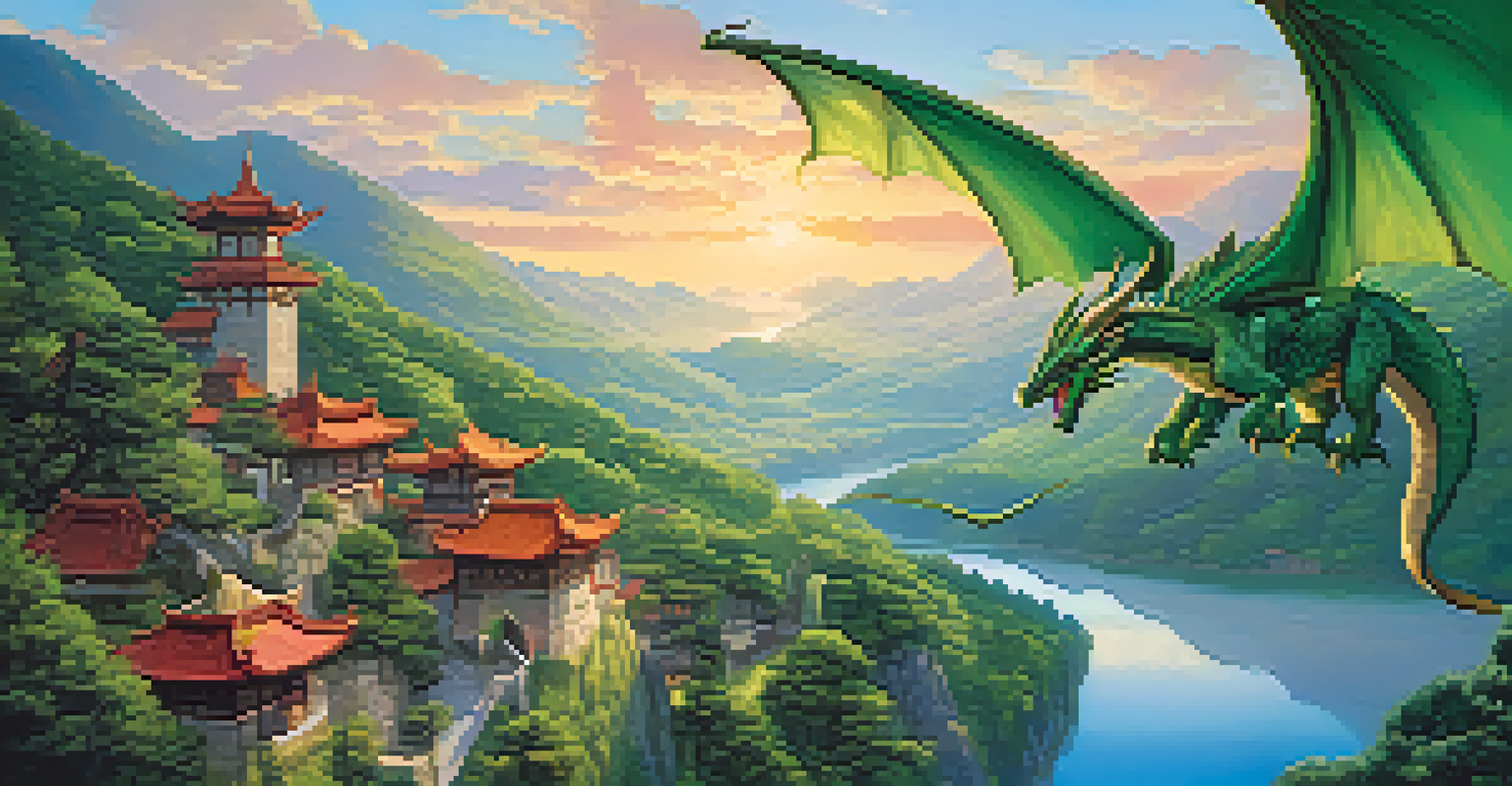Legendary Figures: How Myths Inspire Portraiture in Art

The Allure of Myths in Artistic Expression
Myths have always captivated human imagination, weaving stories that resonate across cultures and generations. These narratives often depict legendary figures whose extraordinary traits inspire artists to create compelling portraits. For instance, the enchanting tales of Greek gods like Zeus and Athena have led to timeless representations in art, showcasing their grandeur and divine nature.
Myth is the most sophisticated form of storytelling, capable of addressing profound truths about the human experience.
Mythology serves as a bridge between the ordinary and the extraordinary, allowing artists to explore themes of heroism, tragedy, and virtue. This exploration often translates into visual storytelling, where the subjects' expressions and poses convey deeper meanings. The art becomes not just a reflection of the figures depicted but also a commentary on human experience, mirroring our aspirations and fears.
Consequently, these portraits do more than adorn walls; they invite viewers into a dialogue about the ideals and values encapsulated in the myths. As we gaze upon these works, we find ourselves reflecting on our own lives and the legendary qualities we admire, making the experience of viewing art both personal and universal.
Iconic Legends That Shaped Portraiture
From the mighty Hercules to the wise Athena, numerous legendary figures have left an indelible mark on portraiture. Artists often draw upon these myths to imbue their works with a sense of grandeur and depth. For example, the portrayal of Venus in various Renaissance artworks illustrates not just beauty but also the complex interplay of love and desire.

Additionally, these iconic figures often embody moral lessons or cultural ideals, making them powerful subjects for artistic interpretation. Take the tale of King Arthur; his depiction in art often highlights themes of chivalry and nobility, resonating with audiences who seek those virtues in their own lives. These portrayals breathe life into myths, transforming them into relatable narratives.
Myths Inspire Artistic Expression
Artists draw on mythical narratives to explore themes of heroism, tragedy, and virtue, creating compelling portraits that resonate with viewers.
Ultimately, the legends inspire artists to delve deeper into human emotions and societal values, allowing viewers to connect with the art on a more profound level. Each brushstroke captures not just a figure, but the essence of a story that has transcended time, reminding us of the power of legends in shaping our understanding of the world.
The Role of Symbolism in Mythical Portraits
Symbolism plays a crucial role in the portrayal of mythical figures, often enriching the viewer's understanding of the artwork. Artists use colors, objects, and even gestures to convey deeper meanings associated with these legendary characters. For instance, the presence of a laurel wreath can symbolize victory and honor, particularly when depicting figures like Apollo, the god of music and prophecy.
Art enables us to find ourselves and lose ourselves at the same time.
Moreover, the arrangement of elements within a portrait can also tell a story. A heroic stance may suggest strength and valor, while a more contemplative pose might evoke wisdom or introspection. This careful consideration of composition allows artists to create multi-layered narratives that invite viewers to explore the complexities of the figures represented.
Thus, through symbolism, mythical portraits become more than just visual representations; they evolve into rich narratives that engage the audience. Each symbol encourages viewers to reflect on the broader themes of mythology and their relevance to contemporary society, bridging the gap between ancient stories and modern life.
Cultural Interpretations of Legendary Figures
Different cultures interpret legendary figures in diverse ways, resulting in unique artistic expressions. For example, the depiction of the dragon varies significantly between Eastern and Western cultures, symbolizing wisdom in the East while often representing chaos in the West. Such differences enrich the artistic landscape, showcasing the versatility of myth as a source of inspiration.
Artists often adapt these figures to reflect their cultural values, beliefs, and experiences. This cultural lens allows for a more nuanced portrayal, inviting viewers to appreciate the complexities of each legend. By examining these variations, we gain insight into the societies that cherish these myths and how they shape their artistic narratives.
Symbolism Enhances Mythical Art
The use of symbolism in mythical portraits adds depth and invites viewers to reflect on the complex stories and themes embedded in the artwork.
Ultimately, these cultural interpretations challenge the notion of a singular truth in mythology. Instead, they celebrate the richness of global perspectives, reminding us that the stories we tell and the figures we admire are shaped by our unique contexts and experiences.
The Evolution of Mythical Portraiture Through History
The portrayal of legendary figures has evolved significantly throughout art history, reflecting changing societal values and artistic movements. During the Classical era, artists focused on idealized forms and harmony, creating portraits that embodied the perfection of the gods. As time progressed, movements like Romanticism shifted the focus to emotion and individuality, leading to more dynamic and expressive representations of mythical figures.
This evolution illustrates how art serves as a mirror to society, adapting to the cultural zeitgeist while still drawing from ancient myths. In modern times, artists continue to reinterpret these legendary figures, often blending traditional elements with contemporary styles. This fusion allows for a fresh perspective, making ancient stories accessible to new generations.
As we trace this evolution, we see that mythical portraiture remains relevant and resonant. Each artistic shift not only honors the legends of the past but also redefines their meaning in light of contemporary issues and values, showcasing the timeless nature of these stories.
The Emotional Connection Through Mythical Art
One of the most powerful aspects of mythical portraiture is its ability to evoke strong emotions. When we encounter a portrait of a legendary figure, we often feel a connection to the stories and ideals they represent. This emotional resonance can inspire awe, nostalgia, or even a sense of longing for the heroism or wisdom depicted.
Artists tap into these emotions by capturing the essence of what makes these figures legendary. The subtlety in a subject’s gaze or the tension in their pose can communicate a wealth of feelings, drawing viewers into the narrative. This emotional connection transforms the viewing experience, making it more immersive and impactful.
Cultural Context Shapes Legends
Different cultural interpretations of legendary figures enrich artistic expression, showcasing the diverse values and beliefs that influence these timeless stories.
In this way, mythical portraits serve not only as artistic representations but also as conduits of human experience. They remind us of our shared stories, encouraging reflection on what we aspire to be and the qualities we cherish, ultimately fostering a deeper understanding of ourselves and our collective history.
Mythical Portraiture: A Reflection of Human Aspirations
At the heart of mythical portraiture lies a reflection of human aspirations and ideals. Legendary figures often embody the traits we strive for, such as courage, wisdom, and resilience. Through these portraits, artists provide a visual representation of our collective dreams, encouraging us to aspire to greatness.
This connection between art and aspiration is particularly powerful because it taps into our innate desire for storytelling. We are drawn to narratives that elevate the human spirit, and mythical portraits serve as a reminder of our potential. They inspire us not only to admire the figures depicted but also to consider how we can embody those qualities in our own lives.

As we engage with mythical portraiture, we find ourselves on a journey of self-discovery. These artworks challenge us to reflect on our values and the legacies we wish to create, making the experience of viewing art a deeply personal and transformative one.